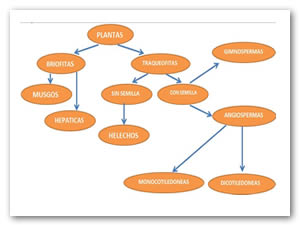
Desde tiempos ancestrales hasta la actualidad, el hombre ha dependido de las plantas, ya que de ellas se obtienen productos para satisfacer necesidades de alimento, vivienda, oxígeno, medicinas, vestido, etc. Su estudio se da a través de la Botánica, el cual ha permitido observar mejor sus características y hacer un mayor uso de ellas. Las plantas tienen un notable valor económico, estético y recreativo, pero sobre todo ecológico ya que gracias a ella se llevan a cabo ciclos vitales en todos los ecosistemas.
Los criterios que se siguen en la clasificación del reino Plantae son las características de la estructura interna de las plantas y de su ciclo biológico.
Para clasificar científicamente las plantas se utilizan básicamente tres criterios: la presencia o ausencia de vasos conductores (el sistema vascular es el conjunto de tubos por el que circulan la savia bruta y la elaborada y que además le sirve de soporte), en otras palabras el xilema y el floema. La presencia o ausencia de flores y de frutos.
De acuerdo a lo anterior podemos clasificar los vegetales en plantas no vasculares (Briofitas: Musgos y Hepáticas) y plantas vasculares (Helechos, Gimnospermas y Angiospermas).
Palabras clave: Reino Plantae, Clasificación, Angiospermas, Gimnospermas.
From ancient times to the present, man has relied on plants, since these products are obtained to meet needs for food, shelter, oxygen, medicines, clothing, etc. Their study is through Botany, which has allowed better observe its characteristics and make greater use of them. Plants have a significant economic, aesthetic and recreational value, but especially ecological because thanks to it out life cycles are carried in all ecosystems. The criteria used in the classification of the kingdom Plantae are the characteristics of the internal structure of plants and their life cycle. To scientifically classify plants three criteria are basically used: the presence or absence of conducting vessels (vascular system is the set of tubes for circulating crude sap and elaborate and also serves as a support), in other words the xylem and phloem. The presence or absence of flowers and fruits. According to the above we can classify plants in non-vascular plants (Bryophyta: mosses and liverworts) and vascular plants (ferns, gymnosperms and angiosperms). Angiosperms represent the most advanced plants, as reproduced from seed covered fruit as an evolutionary mechanism highly successful in terms of sexual reproduction in plants. It is based on morphological classification structures and characteristics of each plant allows to identify to the species level.
Keywords: Kingdom Plantae, classification, Angiosperms, Gimnosperms.
Mapa Conceptual: Clasificación Vegetal
Velázquez Ocampo, M. (2011). Biología II. (2da. ed.). México: Santillana.
Méndez Rosales, Ma. E., Padilla, Rosa y Rocha, J. (2012). Biología Avanzada. México: Book Mart.
[a] Profesor Investigador de la Universidad Autónoma del Estado de Hidalgo.